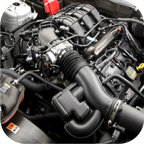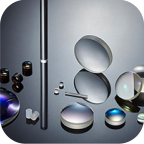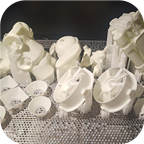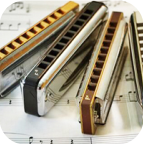Understanding the Piezoelectric Effect in Ultrasonic and Piezoelectric Transducers: Applications and Innovations
Browse Volume:170 Classify:Support
The piezoelectric effect is a fascinating phenomenon that has revolutionized various fields, from medical imaging to industrial automation. At the heart of this technology are ultrasonic and piezoelectric transducers, which convert electrical energy into mechanical vibrations and vice versa. This article delves into the science behind the piezoelectric effect, explores the design and functionality of these transducers, and highlights their diverse applications in modern technology.
The Science Behind the Piezoelectric Effect

The piezoelectric effect was first discovered in 1880 by Pierre and Jacques Curie. It refers to the ability of certain materials to generate an electric charge in response to applied mechanical stress. Conversely, these materials can also deform when an electric field is applied, a phenomenon known as the inverse piezoelectric effect. This bidirectional energy conversion is the foundation of piezoelectric transducers.
Piezoelectric materials, such as quartz, lead zirconate titanate (PZT), and barium titanate, are crystalline structures with asymmetric unit cells. When mechanical pressure is applied, the displacement of positive and negative charges within the crystal lattice creates a dipole moment, resulting in an electric potential. This property makes piezoelectric materials ideal for sensors, actuators, and transducers.
How Ultrasonic Transducers Harness the Piezoelectric Effect

Ultrasonic transducers are devices that emit and receive high-frequency sound waves, typically above the range of human hearing (20 kHz). These transducers rely on the piezoelectric effect to convert electrical signals into ultrasonic waves and vice versa.
In an ultrasonic transducer, a piezoelectric element is sandwiched between electrodes. When an alternating voltage is applied, the piezoelectric material vibrates at a high frequency, producing ultrasonic waves. These waves travel through a medium, such as air or water, and reflect off objects. The returning echoes are detected by the transducer, which converts them back into electrical signals for analysis.
Ultrasonic transducers are widely used in medical imaging, such as ultrasound scans, where they provide real-time images of internal organs and tissues. They are also employed in industrial applications, including non-destructive testing (NDT) and cleaning, where their ability to penetrate materials without causing damage is invaluable.
Design and Functionality of Piezoelectric Transducers

Piezoelectric transducers are versatile devices designed to optimize the piezoelectric effect for specific applications. Their design typically includes a piezoelectric element, electrodes, and a housing that protects the components and enhances performance.
The choice of piezoelectric material is critical, as it determines the transducer’s efficiency, frequency range, and durability. For example, PZT is commonly used for its high piezoelectric coefficients and stability, while quartz is preferred for its precision in timing applications.
The shape and size of the piezoelectric element also play a significant role. For instance, disc-shaped elements are often used for generating omnidirectional waves, while rectangular elements are suitable for directional applications. Additionally, the transducer’s housing is designed to minimize energy loss and protect the piezoelectric element from environmental factors.
Applications of Piezoelectric and Ultrasonic Transducers
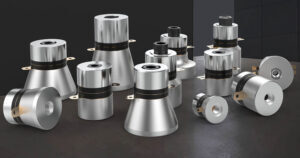
The unique properties of piezoelectric and ultrasonic transducers have led to their widespread adoption across various industries. Below are some of the most notable applications:
1. Medical Imaging and Therapy: Ultrasonic transducers are the backbone of diagnostic ultrasound machines, enabling healthcare professionals to visualize internal structures and monitor fetal development. They are also used in therapeutic applications, such as breaking down kidney stones using high-intensity focused ultrasound (HIFU).
2. Industrial Automation: Piezoelectric transducers are integral to precision positioning systems, such as those used in semiconductor manufacturing. Their ability to produce precise, repeatable movements makes them ideal for applications requiring micron-level accuracy.
3. Non-Destructive Testing (NDT): Ultrasonic transducers are employed in NDT to detect flaws in materials without causing damage. This is particularly important in industries such as aerospace and construction, where structural integrity is paramount.
4. Energy Harvesting: The piezoelectric effect is being explored as a means of harvesting energy from ambient vibrations, such as those produced by machinery or human movement. This technology has the potential to power small electronic devices and sensors without the need for batteries.
5. Consumer Electronics: Piezoelectric transducers are used in everyday devices, such as speakers, microphones, and touchscreens. Their compact size and efficiency make them a popular choice for enhancing user experience.
Innovations and Future Trends in Piezoelectric Technology

As technology advances, researchers are continually exploring new ways to enhance the performance and applications of piezoelectric and ultrasonic transducers. One promising area of research is the development of flexible piezoelectric materials, which could enable the creation of wearable devices and sensors that conform to the human body.
Another exciting trend is the integration of piezoelectric transducers with artificial intelligence (AI) and machine learning. For example, AI algorithms can analyze data from ultrasonic transducers to improve the accuracy of medical diagnoses or predict equipment failures in industrial settings.
Additionally, advancements in nanotechnology are paving the way for miniaturized piezoelectric devices with unprecedented precision and efficiency. These innovations are expected to open up new possibilities in fields such as robotics, healthcare, and environmental monitoring.
The piezoelectric effect has undoubtedly transformed the way we interact with technology, enabling innovations that were once thought impossible. From life-saving medical devices to cutting-edge industrial tools, piezoelectric and ultrasonic transducers continue to push the boundaries of what is achievable. As research and development in this field progress, we can expect even more groundbreaking applications that will shape the future of technology.
References
1. Curie, J., & Curie, P. (1880). “Développement, par pression, de l’électricité polaire dans les cristaux hémièdres à faces inclinées.” *Comptes Rendus de l’Académie des Sciences*, 91, 294-295.
2. Jaffe, B., Cook, W. R., & Jaffe, H. (1971). *Piezoelectric Ceramics*. Academic Press.
3. Smith, W. A., & Auld, B. A. (1991). “Modeling 1-3 composite piezoelectrics: Thickness-mode oscillations.” *IEEE Transactions on Ultrasonics, Ferroelectrics, and Frequency Control*, 38(1), 40-47.
4. Uchino, K. (2000). *Ferroelectric Devices*. CRC Press.
5. Zhang, Q. M., & Li, J. F. (2012). “Piezoelectric materials for high power, high temperature applications.” *Materials Today*, 15(11), 478-486.
 Granbo Sonic
Granbo Sonic





